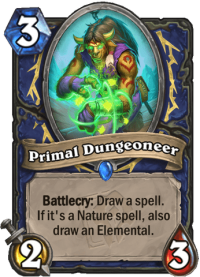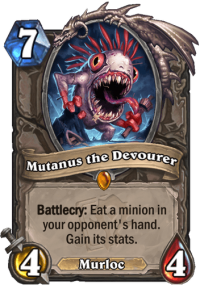How big of an effect can 35 new cards have on the Hearthstone meta? That’s a question that was heatedly debated back when adventures were a thing and we did not have three full expansions every year. Back then, some adventures had a huge effect whereas others were lukewarm at best: 35 strong cards can turn the entire game upside down, but the developers are unlikely to fill the entire mini-set with strong cards. It might be unreasonable to expect another Curse of Naxxramas, but hopefully, we will get more out of each mini-set than One Night in Karazhan.
So far, Wailing Caverns has delivered, at least in combination with the new Paladin nerfs. The meta has changed. The differences between classes are smaller and there are more viable classes now than before. The joy has not been spread equally to fans of all archetypes, but it never is, now is it. Let’s take a deeper look at what has happened!
The Rise of Shaman

I wrote about Shaman shortly before the mini-set cards were announced, and came to the conclusion that Shaman is just a couple of cards away from being great. I did not know that those cards were Wailing Vapor (even though I wanted another one-cost Elemental) and Primal Dungeoneer, but those seem to do nicely. An improved early game and more consistency were exactly the things Shaman needed.
Both of the Shaman archetypes that were on the verge of being playable before the mini-set, Elemental Shaman and Aggro Shaman, are now among the best decks in the game.
Aggro Shaman had a great start, as aggro decks so often have in a new expansion, punishing everyone who dares to experiment with anything sub-optimal:

Wailing Vapor helps the deck get on the board on turn one and Primal Dungeoneer adds some card draw and consistency to the deck. Even Selfless Sidekick seems playable in this archetype, as equipping a Doomhammer directly from your deck is a useful skill to have.
There are also variants without Selfless Sidekick, as Primal Dungeoneer adds a lot of consistency into finding Cagematch Custodian, so you often have a Doomhammer in your hand anyway. As of now, it is still uncertain whether Selfless Sidekick will be part of the deck in the long term.
However, Aggro Shaman’s win rate has already started to fall, and while the deck is still good and seems destined to have a presence in the meta for the rest of Forged in the Barrens, it is not the strongest Shaman deck right now.
Elemental Shaman is doing even better, and it shows no signs of becoming weaker either!

Elemental Shaman has that old midrange feel to it. You mostly play one card per turn, sometimes two, and just steadily build up an overwhelming advantage. Again, the deck makes the most out of Wailing Vapor and Primal Dungeoneer for improved early game and more consistency. Some direct damage spells are available either for defending yourself against faster aggro decks or for finishing off the opponent later in the game.
Elemental Shaman’s game plan is not a complicated one, but sometimes it feels nice to just play a straightforward midrange deck that cares about the board and builds up an advantage over time. Oh, and Elemental Shaman is one of the top three decks in the game right now, so there’s that, too.
There have been attempts to build some other Shaman decks as well. Luckily (?), Evolve Shaman has not been that great even with Selfless Sidekick, so anyone traumatized by Evolve Shaman’s previous eras of domination can still sleep their nights at peace.
The mini-set also included some potential tools for Control Shaman: Perpetual Flame, Archdruid Naralex, and Mutanus the Devourer. Unfortunately, these do not seem to be enough to make Control Shaman viable. That is not a big surprise, as control decks have had a very hard time in Forged in the Barrens.
The Deathrattle Awakens
Another big winner of the mini-set is Deathrattle Demon Hunter.

Deathrattle Demon Hunter received some sweet cards in the mini-set: Sigil of Summoning, Felrattler, and Devouring Ectoplasm. The incredibly powerful Razorboar and Razorfen Beastmaster needed some new targets to summon, and now they got them!
Right now, most people are playing variations of the deck with N'Zoth, God of the Deep, but its performance statistics are hinting that perhaps a faster approach would be better. There is also considerable anti-synergy between the 2/2 Demons from Sigil of Summoning and Illidari Inquisitor if you run a N’Zoth variant of the archetype.
A non-N’Zoth version of the archetype could look something like this:
Either way, Deathrattle Demon Hunter needs to solve its Face Hunter matchup to shine, and at least Death's Head Cultist has become a must-have in the deck. Some versions are even running Armor Vendor or Eye Beam to better survive against aggro.
The archetype is still evolving and its exact composition depends on how common aggro decks will be as we move deeper into the new meta. Deathrattle Demon Hunter is already capable of demolishing all slower decks, but it has to tech to reliably beat aggro, which may give slower decks a chance against it. Once the meta is more stable and the deck can be teched appropriately, it has a good chance to be the best deck in the game.
The Last Control Deck
Forged in the Barrens has not been kind to control decks. Control Warlock with Tickatus has been more popular than its performance has warranted, but now it seems to finally be non-existent, which is in line with its performance statistics. Then there’s Control Warrior, which became more popular in the mini-set (especially after many players brought it to this weekend’s Grandmasters Finals), but stats tell the whole story – despite being quite popular, its win rate puts it right into Tier 4.
However, the mini-set has improved one control deck. If you want to play control in the current meta, your deck of choice is Priest!

Control Priest has undergone slow refinement throughout Forged in the Barrens. It started with all the random stuff you can imagine, evolved into Flesh Giants for some proactive moves, and finally ditched the Giants and moved to N'Zoth, God of the Deep, Southsea Scoundrels, and Lightshower Elementals as their proactive package, still supported by tons of random resource generation.
The mini-set adds Mutanus the Devourer to give Priest a new tool to fight against combo decks, and it reopens the stealing package because Against All Odds has good synergy with Wave of Apathy and brings Cabal Acolyte back with it.
You can still just kill Priest before they find their good cards, and Tickatus can still work against them as well, but Priest’s toolkit is stronger now than at any point in Forged in the Barrens, and its incredible resource generation can outvalue any other control decks. It is the last control deck still standing, for better or for worse.
Why Play New Cards?
Many of the best decks in the game right now use none of the new cards. For example, Token Druid, Face Hunter, and Miracle Rogue are currently top-tier decks, and none of them got anything in the mini-set. If you skipped the mini-set, these are some of the top options available to you without any new cards:
Is Wailing Caverns a Success?
I have mixed feelings about Wailing Caverns.
There are undeniable good aspects to the mini-set. It successfully resurrected Shaman as a strong but not oppressive class. It brought Deathrattle Demon Hunter to the top of the meta, again as a strong but not an oppressive deck. It brought a much better balance to the game, with more viable classes than before in Forged in the Barrens. This sounds like a great set!

However, Wailing Caverns could have done more. Warlock remains in shambles (in Standard, the situation is quite the opposite in Wild), the set failed to bring good cards for them, as neither Zoo nor Control Warlock got adequate support. Likewise, the Mage cards from the mini-set are awful and Mage can still only play No Minion Mage, which is getting weaker and weaker in comparison to the opponents. Mage needed some good minions to not further promote No Minion Mage and to open up another archetype, but it got complete memes instead.
In fact, the majority of classes did not get anything useful from the mini-set. Several cards were experimented with briefly on day one, but they proved to be too weak and were abandoned almost instantly. Some of the cards may be strong once they have more support, such as Kresh, Lord of Turtling, Lady Anacondra, and Stealer of Souls, but the latter two are more at risk of completely breaking the game than seeing play in a strong but balanced deck.
The mini-set also did nothing to address the current archetype imbalance in the game. Card games usually rely on a healthy balance of aggro, midrange, control, and combo decks, but in Hearthstone, control and combo are almost dead. This makes individual Hearthstone games nasty, brutish, and short. The rare control deck game you encounter will be against Priest and full of randomly generated resources that may or may not be the right answers to whatever threats you attempt to present.
At this point, it is possible that this design is intentional. Short, flashy games are perhaps the goal of the development team. If that is the Hearthstone you enjoy, Wailing Caverns widened the pool of viable classes and possibly provides exactly the experience you seek.













































































































I immediatly replaced Selfless Sidekick with Bru’kan, for reasons you mentioned (regarding Sidekick). Works fine.
Yeah warlock is close to broken in wild, but then again it’s real fun to play
The decks I have tried this far is:
Stealer of Souls, and Mech Thun or Just big minions is fun and a bit crazy at times.
The same with the new armor druid and togwaggle druid. So I think they are rather fun, but they may need a nerf if they ever want the game to slow down a bit again.
Mini set has done its job by nerfing Paladin and reinvigorating Shaman. It is now a more healthier time than before the miniset. From future expansions, I wish to see fewer secrets and no cheap discover cards.